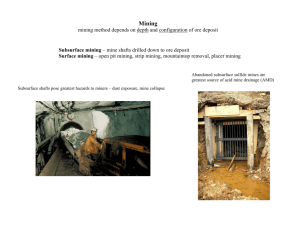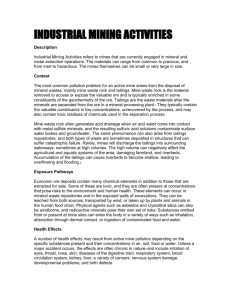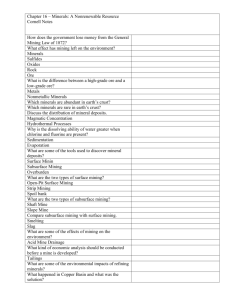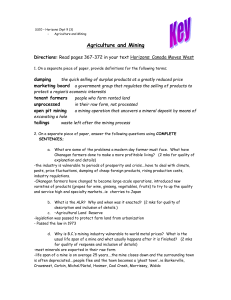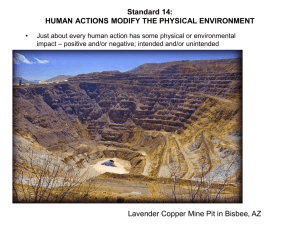MINERALS & MINING
advertisement
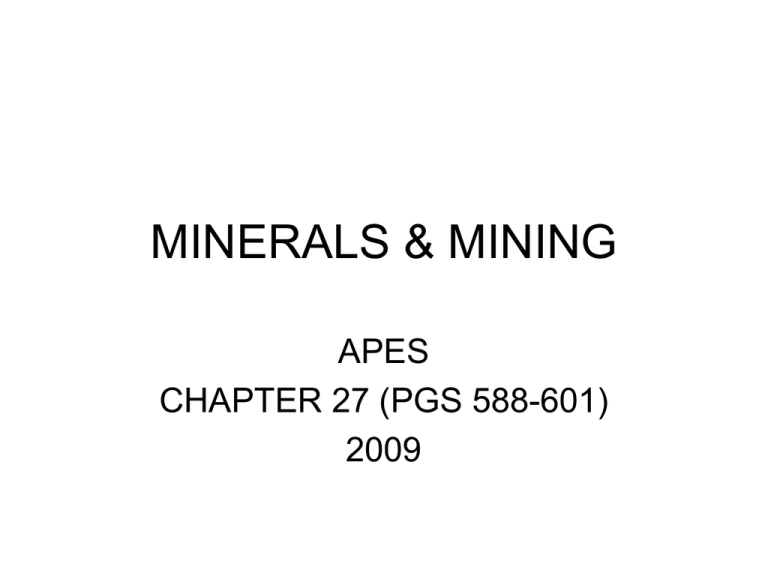
MINERALS & MINING APES CHAPTER 27 (PGS 588-601) 2009 Economic mineralogy • Study of minerals heavily used in manufacturing. • Important part of domestic & international commerce • Mostly metal ores • Some non-metallics are: graphite, quartz, diamonds • Many resources are spread out- important to find them concentrated in economically recoverable levels. Metal Resources Metal Uses Millions Metric Tons Annually Iron Heavy machinery, steel production 740 Aluminum Packaging foods & beverages, transportation, electronics 40 Manganese High-strength, high-resistant steel alloys 22.4 Copper Building construction, electric/electroni industry 8 Chromium High strength steel alloy 8 Nickel Chemical industry, steel alloys 0.4 Lead Leaded gasoline, car batteries, paint, ammunition Silver Photography, electronics, jewelry Gold Medical, aerospace, electronic use, money, jewelry Platinum Automobile catalytic converters, electronics, medical uses, jewelry- Metal Resources Biggest Users of Metals • United States • Japan • Europe Biggest Producers • South America • South Africa • Former Soviet Union . Non-Metal Resources • Sand & gravel (highest volume & dollar value than any other non-metal & greater volume than metals) – Uses: brick & concrete construction, paving, road filler, sandblasting, glass (high silica content sand) • Limestone – Uses: concrete, road rock, building stone, pulverized to neutralize acidic soil or water. • Evaporites- halite, gypsum, potash – Uses: halite- rock salt for roads, refined into table salt – Gypsum- makes plaster wallboard – Potash- for fertilizer (potassium chloride, potassium sulfates) • Sulfur deposits – Uses: sulfuric acid in batteries & some medicinal products Strategic Metals & Minerals • We depend on about 80 metals & minerals • 18 of these are considered rare & in short supply – EX: Tin, platinum, gold, silver, & lead • Some are strategic resources- we use but cannot produce ourselves. Strategic Metals & Minerals • If foreign politics, government are unstable, could cut off supplies, causing a crippling of economy or military strength • We stockpile when resource is cheap & available “just in case.” • EX: bauxite (ore containing aluminum), manganese, chromium, tin, cobalt, tantalum, palladium, platinum • Many LDC sell their strategic resources to make money for country. – Zambia- 50% of national income comes from cobalt exports. Steps in Obtaining Mineral Commodities • Prospecting- finding places where ores occur • Mine exploration & development- learn whether ore can be extracted economically • Mining- extract ore from ground • Beneficiation- separate ore minerals from other mined rock • Smelting & refining- extract pure mineral from ore mineral (get the good stuff out of waste rock) • Transportation- carry mineral to market • Marketing & sales- find buyers & sell the mineral Types of Mining • Surface- scoop ore off surface of the earth or dig big holes and scoop – Cheap – Safe for miners – Large amount of environmental destruction • Subsurface- use shafts to reach deeply buried ores – Expensive – Hazardous for miners – Less environmental damage Types of Surface Mining 1. Open Pit Mining a. Overlaying material is removed using large equipment b. Creates pits that are hundreds of meters wide and hundreds of meters deep. Types of Surface Mining 2. Strip mining – Like open pit but not as deep of a pit – Same environmental damage Large bucket wheel extractor being moved through Germany. Moves 10 meters per minute. Takes 5 people to operate. Used in strip mining Types of Subsurface mining • Variety of methods • Uranium mining Types of Subsurface Mining • Dredging – Sand is removed from bottom of ocean – Can be done to restore beaches (after hurricane) – Destroys fragile benthic ecosystems Mining Issues Mine Safety: In U.S., stringent mining regulations have lead to a reduction in fatalities, both in terms of total deaths per year, deaths per person-hour worked, and deaths per ton mined. surface Health Problems • mine collapse • fire (methane, coal dust, etc.). • asphyxiation (methane, carbon monoxide) • pneumoconiosis (from inhaling coal dust) • asbestosis (from inhaling asbestos fibers) • silicosis (from inhaling silicate dust) • heavy metal poisoning (e.g. mercury) • radiation exposure (in uranium mining) Environmental Damage • • • • • • • • • Gaping holes in ground (old open pit mines) Accidental draining of rivers and lakes Disruption of ground water flow patterns Piles of gangue- mine tailings (mining waste) Loss of topsoil in strip-mined regions (350 to 2,700 km2 in US alone) Spoil banks are where holes were filled in with waste- cheap & easysusceptible to erosion, chemical weathering, causes high sediment runoff in watersheds. Steep slopes are slow to re-vegetate (succession happens slowly- no topsoil) Contamination of soil or water from heavy metals (e.g. arsenic, mercury) in mine tailings. Contamination from sulfuric acid (H2SO4) produced through weathering of iron sulfide (FeS2, pyrite) in tailings. – 4FeS2 + 14H2O = 4Fe(OH)3 + 8H2SO4 Water leaking into mine shafts, washes dissolved metals & toxic material into water sources. – (550,000 abandoned mines in U.S.- 12,000 mi of rivers & streams contaminated with mine drainage- cost to clean up $32-$72 billion) Coeur D' Alene Mine in Colorado “Gangue”- mine tailings Acid Mine Drainage Acid Mine Drainage The impact of mine drainage on a lake after receiving effluent from an abandoned tailings impoundment for over 50 years Relatively fresh tailings in an impoundment. http://www.earth.uwaterloo.ca/services/whaton/s06_amd.html The same tailings impoundment after 7 years of sulfide oxidation. The white spots in Figures A and B are gulls. Mine effluent discharging from the bottom of a waste rock pile (gangue) Shoreline of a pond receiving AMD showing massive accumulation of iron hydroxides on the pond bottom Surface Mining Control & Reclamation Act (SMCRA) • 1977 • Requires better restoration of strip-mined lands • Restoration is difficult & expensive • Takes long time for soil to regain fertility – Topsoil gets buried – Compacted, poor drainage – Root growth restricted • Minimum cost- $1000 per acre • Complete restoration (if possible)- $5,000 per acre Beneficiation Processing Mineral/metal Two methods 1. Smelting- heating ore to release metal a. b. c. 2. Causes pollution (see next slide) Produces slag (waste) which must be disposed of- may be toxic Releases small amounts of heavy metal (As, Cd, Hg) Chemical treatment a. Heap-Leaching Used to separate gold from ore Create huge piles of ore, spray with dilute alkaline-cyanide solution, percolates thru pile to dissolve gold which is collected from runoff Supposed to have clay or plastic liners under pile Summitville mine near Alamosa, Colorado was abandoned after the owners extracted $98 million in gold then declared bankruptcy in 1992. Will cost EPA $100 million to clean up Georgia vs. Ducktown, TN (1915) • • • In 1800’s began mining copper in Ducktown, TN Built huge open air wood fires by cutting down trees in area. Burned ore to release copper Damage caused: – Clouds of sulfur dioxide released from burning sulfide ore poisoned plants & acidified soil. – Massive interstate air pollution – Rain caused massive erosion – Siltation of reservoirs on Ocoee River impaired electricity generation by the Tennessee Valley Authority (TVA) • • In 1930’s clean up began- spend $250,000 per year for clean up Trees still spindly, but only 4% of area is still “denuded” 1940’s Now How can we conserve geologic resources? • Recycling – Saves energy • Recycling aluminum cans requires 1/20th the energy than extracting aluminum from bauxite (aluminum ore) • Only 2/3 of aluminum actually recycled • See Table – Reduces need for mining which reduces overall environmental impact – Minimills becoming more common- remelt & reshape waste scrap iron & steel. Cost comparison: $225$480 per metric ton while regular steel mills cost $1425-$2250 per metric ton. – Ex: platinum (catalytic converters), gold, silver, copper, lead, iron, steel How can we conserve geologic resources? • Substituting New Materials for Old – History: Stone age, bronze age, iron age – Plastic PVC instead of copper, lead, steel pipes – Fiber optic technology and satellite communication reduces the need for copper telephone wires – Steel replaced by aluminum, polymers, alloys that reduce weight & cost, increase fuel efficiency in cars


